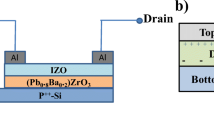Abstract
In this work, boron–indium-oxide (BIO) thin-film transistors (TFT) have been fabricated by a solution based processing method. We have studied the structural, morphological, optical and electrical properties of solution processed BIO thin-film for TFT applications. The dopant boron was chosen as an effective carrier suppressor in indium oxide thin-film, owing to high Lewis acid strength, electro-negativity, small ionic size and high boron-oxygen bonding strength. The boron concentration in the indium oxide precursor solution was varied from 0 to 50 at.%. X-ray diffraction analysis confirms the transition of polycrystalline indium oxide thin film to amorphous nature from boron concentration of 20 at.% and above. The thin-films had a uniform smooth surface with an average surface roughness between 0.10 and 0.17 nm. Moreover, the thin-films were shown to be highly transparent (> 86%) in the visible region. The synthesized BIO thin-film was patterned and used as the active channel layer for TFT devices that were fabricated. The BIO (25 at.% boron) TFT post-annealed at 350 °C exhibited amorphous nature with a field effect mobility of 0.8 cm2/V s with threshold voltage at 6.8 V and ION/IOFF of about 4.5 × 108.







Similar content being viewed by others
References
K. Nomura, H. Ohta, A. Takagi, T. Kamiya, M. Hirano, H. Hosono, Nature 432, 488 (2004). https://doi.org/10.1038/nature03090
T. Kamiya, K. Nomura, H. Hosono, J. Disp. Technol. 5, 273 (2009). https://doi.org/10.1109/JDT.2009.2021582
H.A. Kim, J.O. Kim, J.S. Hur, K.S. Son, J.H. Lim, J. Cho, J.K. Jeong, IEEE Electron Device Lett. 65(11), 4854–4860 (2018). https://doi.org/10.1109/TED.2018.2868697
M.H. Cho, H. Seol, H. Yang, P.S. Yun, J.U. Bae, K.S. Park, J.K. Jeoong, IEEE Electron Device Lett. 39(5), 688–691 (2018). https://doi.org/10.1109/LED.2018.2812870
Y.-H. Kim, J.-S. Heo, T.-H. Kim, S. Park, M.H. Yoon, J. Kim, M.S. Oh, G.-R. Yi, Y.-Y. Noh, S.K. Park, Nature 489, 128 (2012). https://doi.org/10.1038/nature11434
C. Avis, J. Jang, J. Mater. Chem. 21, 10649 (2011). https://doi.org/10.1039/C1JM12227D
M.G. Kim, H.S. Kim, Y.G. Ha, J. He, M.G. Kanatzidis, A. Facchetti, T.J. Marks, J. Am. Chem. Soc. 132, 10352 (2010). https://doi.org/10.1021/ja100615r
Y.G. Kim, T. Kim, C. Avis, S.-H. Lee, J. Jang, IEEE Trans. Electron Devices 63, 1078 (2016). https://doi.org/10.1109/TED.2016.2518703
S. Parthiban, J.-Y. Kwon, J. Mater. Res. 29, 1585 (2014). https://doi.org/10.1557/jmr.2014.187
N. Gong, C. Park, J. Lee, I. Jeong, H. Han, J. Hwang, J. Park, K. Park, H. Jeong, Y. Ha, Y. Hwang, SID Symp. Digest Techn. Pap. 43, 784 (2012)
J.S. Park, T.W. Kim, D. Stryakhilev, J.S. Lee, S.G. An, Y.S. Pyo, D.B. Lee, Y.G. Mo, D.U. Jin, H.K. Chung, Appl. Phys. Lett. 95, 013503 (2009). https://doi.org/10.1063/1.3159832
J.W. Hennek, J. Smith, A. Yan, M.G. Kim, W. Zhao, V.P. Dravid, A. Facchetti, T.J. Marks, J. Am. Chem. Soc. 135, 10729–10741 (2013). https://doi.org/10.1021/ja403586x
N. Mitoma, S. Aikawa, W. Ou-Yang, X. Gao, T. Kizu, M.F. Lin, A. Fujiwara, T. Nabatame, K. Tsukagoshi, Appl. Phys. Lett. 106, 042106 (2015). https://doi.org/10.1063/1.4907285
K. Kurishima, T. Nabatame, T. Onaya, K. Tsukagoshi, A. Ohib, N. Ikeda, T. Nagata, A. Ogura, ECS Trans. 86(11), 135–145 (2018). https://doi.org/10.1149/08611.0135ecst
S.H. Lee, T. Kim, J. Lee, C. Avis, J. Jang, Appl. Phys. Lett. 110, 122102 (2017). https://doi.org/10.1063/1.4978932
J.I. Kim, K.H. Ji, M. Jang, H. Yang, R. Choi, J.K. Jeong, ACS Appl. Mater. Interfaces 3(7), 2522–2528 (2011). https://doi.org/10.1021/am200388h
K.A. Stewart, V. Gouliouk, D.A. Keszler, J.F. Wager, Solid-State Electron. 137, 80–84 (2017). https://doi.org/10.1016/j.sse.2017.08.004
D.Y. Zhong, J. Li, Y.H. Zhou, C.X. Huang, J.H. Zhang, X.F. Li, J. Huang, X.Y. Jiang, Z.L. Zhang, Superlattices Microstruct. 122, 377–386 (2018). https://doi.org/10.1016/j.spmi.2018.07.004
D.Y. Zhong, J. Li, C.Y. Zhao, C.X. Huang, J.H. Zhang, X.F. Li, X.Y. Jiang, Z.L. Zhang, IEEE Trans. Electron Devices 65(2), 520–525 (2018). https://doi.org/10.1109/TED.2017.2779743
S. Gandla, S.R. Gollu, R. Sharma, V. Sarangi, D. Gupta, Appl. Phys. Lett. 107, 152102 (2015). https://doi.org/10.1063/1.4933304
X. Zhang, B. Wang, W. Huang, Y. Chen, G. Wang, L. Zeng, W. Zhu, M.J. Bedzyk, W. Zhang, J.E. Medvedeva, A. Facchetti, T.J. Marks, J. Am. Chem. Soc. 140(39), 12501–12510 (2018). https://doi.org/10.1021/jacs.8b06395
R. Takata, A. Neumann, D. Weber, D.V. Pham, R. Anselmann, Y. Kitamura, T. Kakimura, S. Suzuki, S. Minami, M. Kodama, J. Soc. Inform. Display 24(6), 381–385 (2016). https://doi.org/10.1002/jsid.450
S. Parthiban, V. Gokulakrishnan, K. Ramamurthi, E. Elangovan, R. Martins, E. Fortunato, R. Ganesan, Sol. Energy Mater. Sol. Cells 93(1), 92–97 (2009). https://doi.org/10.1016/j.solmat.2008.08.007
V. Gokulakrishnan, S. Parthiban, K. Jeganathan, K. Ramamurthi, Appl. Surf. Sci. 257, 9068–9072 (2011). https://doi.org/10.1016/j.apsusc.2011.05.102
M. Mativenga, J.K. Um, D.H. Kang, R.K. Mruthyunjaya, J.H. Chang, G.N. Heiler, T.J. Tredwell, J. Jang, IEEE Trans. Electron Devices 59, 9 (2012). https://doi.org/10.1109/TED.2012.2205258
D. Gupta, M. Katiyar, D. Gupta, Proc. ASID 6, 425–428 (2006)
Acknowledgements
The authors are thankful to the Department of Science and Technology-Science and Engineering Research Board, Government of India for financial support under the early career research award (File No. ECR/2016/000785).
Author information
Authors and Affiliations
Corresponding author
Additional information
Publisher's Note
Springer Nature remains neutral with regard to jurisdictional claims in published maps and institutional affiliations.
Rights and permissions
About this article
Cite this article
Arulkumar, S., Parthiban, S., Gnanaprakash, D. et al. Solution processed boron doped indium oxide thin-film as channel layer in thin-film transistors. J Mater Sci: Mater Electron 30, 18696–18701 (2019). https://doi.org/10.1007/s10854-019-02222-y
Received:
Accepted:
Published:
Issue Date:
DOI: https://doi.org/10.1007/s10854-019-02222-y




